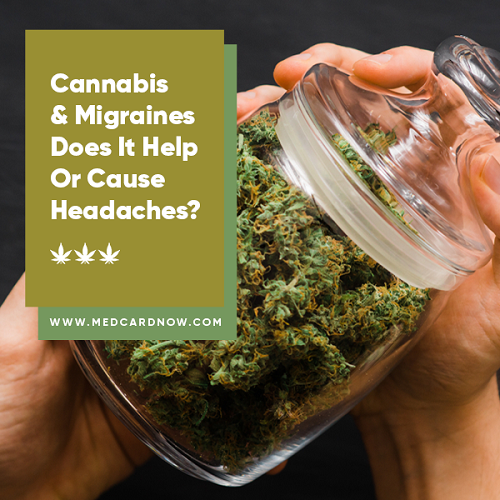
In almost 1 in 4 American households, there is a person living with migraines. It’s such a widespread problem that over 12% of the entire population, including children, suffer from this chronic health disorder. Now it’s a question about Cannabis and Migraines – Does it Help or Cause Headaches?
For individuals who regularly have to deal with it, life can be very challenging. Even the simplest stimuli that might be harmless to others can trigger a migraine attack. Anything from potent aromas, loud screeching, to bright lights can be a serious trigger. The worse the trigger, the more crippling the pain is.
Though conventional drugs for migraines can help ease the symptoms, they don’t work that well for all patients. Plus, they expose people to serious side effects. For a healthier treatment choice, people often turn to cannabis.
The question is, does it help or cause these headaches? Can you rely on cannabis treatments for chronic head disorders? Here, we will take a closer look at cannabis and migraines, including all the practical info you need to know.
Using Cannabis for Headache Disorders
The concept of using cannabis for headaches is nothing new. Based on historical records, cannabis was the go-to treatment for headache and migraine pain for many decades. Plenty of prominent doctors between the late 1800s and mid-1900s relied on this medicinal herb to curb the symptoms.
Its compounds proved incredibly effective for soothing the pain and controlling the triggers. But, when medications became widely available, they seemed to show a lot of promise for managing chronic pain. The attention slowly shifted to conventional medicine.
Can Cannabis Help or Cause Headaches?
There are many treatments for migraines that promise remarkable results. But, not all of them create the effects you might expect. Cannabis can topple most of them.
According to clinical studies published by Washington State University, inhaling cannabis can have innumerable benefits for soothing migraine symptoms.
In fact, it cuts the migraine pain by nearly 50%. Based on their reports, inhaling its medicinal properties can reduce the severity of self-reported headaches by 47.3%. While for migraines, it can reduce it by 49.6%. For migraine patients, this can prove immensely beneficial.
Another research published the same year showed similar results. Out of the 279 patients evaluated, 88.3% reported a reduction in headache pain after taking cannabis. But that’s not all. Almost 50% of them dropped the headache rates, while 38.3% stated they noticed a significant improvement in their quality of sleep.
The Impact of the Endocannabinoid System on Migraines
Experts believe that medical marijuana has a major effect on the nerves, and it is all thanks to its endocannabinoid system. Enough evidence supports the effect of this system on migraine treatments.
Once medical cannabis is ingested, the body will naturally start to process it. Eventually, it will reach the nervous system and emit all its therapeutic properties.
The medicinal compounds in the cannabis plants will search the body for the receptors. When they find them, they will infiltrate them and soothe the pain signals. The smoked cannabis will decrease the inflammation in the matter tissue and minimize the damage of migraine triggers. This is why cannabis users quickly start to feel migraine relief.
Because of how beneficial it actually is, plenty of states permit the use of medicinal cannabis. It is a proven method for successful headache treatment.
- When Is the Right Time to Dose?
Even though plenty of evidence supports the effects of cannabis for migraines, there is still not enough practical information yet. Guides on how much, when, or how to take this treatment are lacking. That’s why it’s crucial to figure out the best approach before you decide to use the cannabis flower.
Some people use the plant as a prophylactic, mainly to stop the onset of migraines. With this method, the body relaxes the muscles and eases the stress. Others prefer to use it as a treatment that deals with nausea and pain.
According to experts, it might be best to use cannabis at the first sign of trouble. The moment you think you are noticing the symptoms, you should take a dose. This tactic can come in handy when trying to reduce or eliminate the triggers, particularly when focusing on dealing with the first signs of pain.
But, in many cases, the plant can work for both treatings and preventing these chronic issues. Since it’s much easier to control the triggers with a cannabis concentrate, it can overcome the cluster headaches.
The problem is that this health disorder has a complex set of triggers, causes, and symptoms. For some patients, it can be best to take a dose as a preventive measure, while for others, it would be ideal for treating the issue after the first symptoms.
The medicinal plant can have a diverse impact, which could affect its potency. That’s why it might be best to experiment at first and see how the plant works for you. That way, you can tailor the treatment to your needs.
- What’s the Most Effective Delivery Method?
Plenty of studies have evaluated the effects of inhaling and taking oral medicinal marijuana. Even though right now, we need more evidence that compares the two methods, we could guess which is the better alternative.
Smoking might not be best for everyone. If people have inhaling difficulties or health conditions that put a strain on their lungs, it will make the treatment process very difficult. In cases such as these, oral delivery might be the better alternative. But, it doesn’t mean it’s the most effective one.
The complex nature of the health condition makes it difficult to pinpoint the most efficient delivery method. There are many variables. For example, some patients may find inhalation to be better than oral consumption.
But, if you really want to make the most of it, many people settle for vaping. It gives excellent dose control and better bioavailability.
Conclusion
Cannabis could be an excellent option for managing migraines. While it isn’t a conventional treatment method, it has plenty of beneficial properties. For people who are considering to try alternative medicine, it can be worth it.
References
https://migraineresearchfoundation.org/about-migraine/migraine-facts/
https://www.sciencedirect.com/science/article/abs/pii/S0304395998000335
https://www.sciencedaily.com/releases/2019/11/191125100353.htm
https://n.neurology.org/content/92/15_Supplement/P3.10-015.abstract
https://www.leafly.com/news/health/how-cannabis-can-help-migraines
https://www.webmd.com/migraines-headaches/qa/how-does-marijuana-work-to-treat-migraines
https://www.cannabisclinics.ca/medical-cannabis/migraines/



